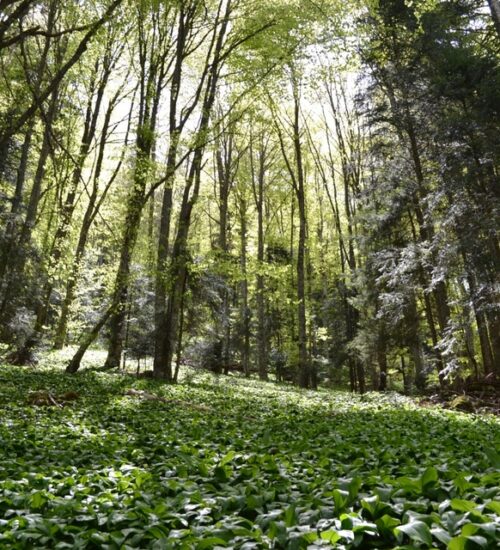


Location
Nature Park “Cicelj” is located in the eastern part of the Republic of Srpska, on the territory of the municipality of Čajniče. The area lies directly next to the town of Čajniče, east and south of it. It is mostly on the northern sides of the Kovač massif.
The total area of state forests and forest land in the Cicelj Nature Park occupies an area of 185.59 ha or 56% of the total area covered.
History
The first legal protection of the Cicelj area dates back to 1969, when the Institute for the Protection of Cultural Monuments of Bosnia and Herzegovina placed this area under protection with Decision No. 06-31-1/69. Now the “Cicelj” nature park is managed by the “Vučevica” Čajniče municipality.
Nature
The protected area includes the center of Cicelje, whose roof of the anticline extends for 1.5 km from the top of Stražica in the south to the elevation in the north. The body is wider in the northern part, and narrower in the southern part, because Cicelj is a lateral anticline of the Kovača ridge (which stretches in the east-west direction), from which it “emerges”, hovering over the incised gorge of Janjina. The flanks of the Cicelja anticline are very steep, especially on the northwestern and northern sides, where the slope reaches high values (>60°). The lowest point is located in the northwestern part, where Janjina leaves the Area, and is 768 m. The highest point is the peak of Stražica (1432 m). Therefore, the hypsometric amplitude is 664 m. Other peaks are lower: Trojan (1337 m), Cicelj (1281 m) and Orlovice (990 m). The river Janjina here, within its scope, has a gorge narrowing, from which it emerges into a narrow valley, below the town and further downstream. The northern coast of this gorge is a volcanogenic formation, known as Orlovica (Orlovica rocks). South of Stražica, the ridge descends steeply to the south, passing over the Anski dolovi to the Trojan hill, which rises alone, in the northeastern part of the karst basin known as Ponikve.
From the northern to the southern point, the energy of the relief gradually decreases, so the relief is of a very wide range, from cliffs to flat meadows.
The southeastern slopes of Cicelja are occupied by a mesoclimatically conditioned forest of beech and fir, without spruce (Abieti-Fagetum), with a mountainous character.
Inside the forest of beech and fir without spruce (Abieti-Fagetum), on the southeastern edge (Klani dolovi) there are mesophilic meadows of Festuco-Agrostetum. Under the canopy, the edges of these meadows acquire the character of a specific transitional vegetation, the indicator of which is hellebore (Veratrum lobelianum Bernh. 1807). On the clearings on the slightly gentler slopes east of the top of Cicelje, after the cessation of mowing and grazing, there was a succession of aspens (Populetum tremulae, Populo abietum).
The vast forest of beech-fir-spruce (Piceo-Abieti-Fagetum) is the most widespread phytocenosis. The mountain climate did not offer people an alternative: as much-needed firewood, beech has always had an advantage over chamovin. The result of this long and systematic anthropogenic factor is the emergence of a secondary dark coniferous taiga of fir and spruce (Abieti-Piceetum-moesiacum), which today occupies a larger area than the primeval forest, as well as pure spruce forests (Piceetum montanum). By clearing the primary forest, acidified types of Festuco-Agrostetum mountain meadow communities were obtained; on shallower land, this led to the development of meadows with heron (Agrostio-Asphodeletum albae), and their abandonment resulted in marginal heathland with blueberry (Vaccinietum myrtilli). The above-mentioned meadows and heaths have for the most part begun the vegetation progression through juniper and maple (Juniperetum communis, Junipero – Piceetum, Aceri-Piceetum). Group fellings of the taiga created and continue to create islands of nitrohygrophilous vegetation of fells, e.g. With nightshade (Atropetum belladonae), bull’s eye (Telekietum speciosae) or raspberry (Rubetum idaei). The type of taiga fir with a branch (Spiraeo-Abietetum), thanks to its virtuous slope, was spared significant changes (it is the closest to the rainforest state). On the other hand, ancient fires removed the original pine (Humilo-Pinetum nigrae) from the limestone ridges and peaks, so today we find grassy rock gardens with Bosnian iris (Potentillo-Caricetum humilis) in their place.
Mountain taiga of spruce and fir (Abieti-Piceetum) is by far the largest ecosystem in Cicelje, which is widely distributed in the wider area (Vučevice, Stakorine, Kovača). It represents secondary forest, i.e. an anthropogenic derivative of the previous community. With the loss of beech, the mature forms of humus were replaced by raw ones, the forest lost its neutrophilic character, which was accompanied by changes in the floristic composition. The geospectrum got more boreal and circumpolar geoelements, and the coenospectrum more acidophyte-oligophyte syntaxons, to the detriment of meso-neutrophytes. The previously mentioned species can be joined by the species Lonicera alpigena, Monotropa hypopytis, Omalothecca sylvatica, Oxalis acetosella… Impressive, perfectly straight conifer trees, an organic horizon made of bristles, air enriched with essential oils – provide recognizable attributes of mountain park-forests.
Tourism
Hotel tourism
Mountain tourism
Spa tourism (air spa)
Adrenaline tourism (canyoning..)
Children’s and youth tourism, arrangement of leisure centers such as
of semi-functional units with various recreational facilities, sports and eco
Camps, space for schools in nature, workshops, art colonies, excursion routes
arranging and equipping picnic areas, viewpoints and recreational trails, info points,
Hospitality facilities
Sports-recreational with the arrangement and construction of suitable facilities, cycling, trim tracks, etc.
Cultural and event tourism through the affirmation of the natural and created values of the area
Religious tourism
Zip line
Driving ATVs
Adrenal tracks.
Kontakt podaci
Manager: ŠG “Vučevica” Čajniče
Address: Kralja Petra I oslobodioca, 13.
73280
Čajniče
Telephone: + 387 (0) 58 315 326
Fax: + 387 (0) 58 315 326
Email vucevica@sumers.org





